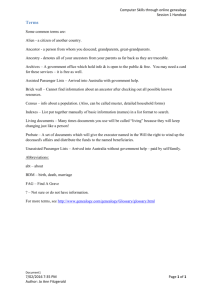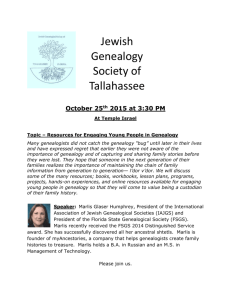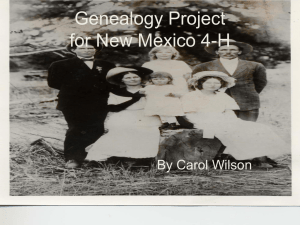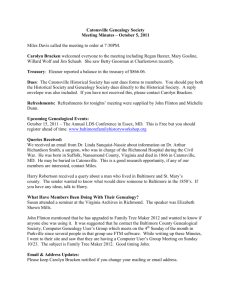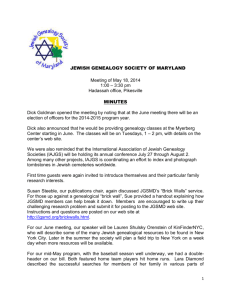Additional Document
advertisement
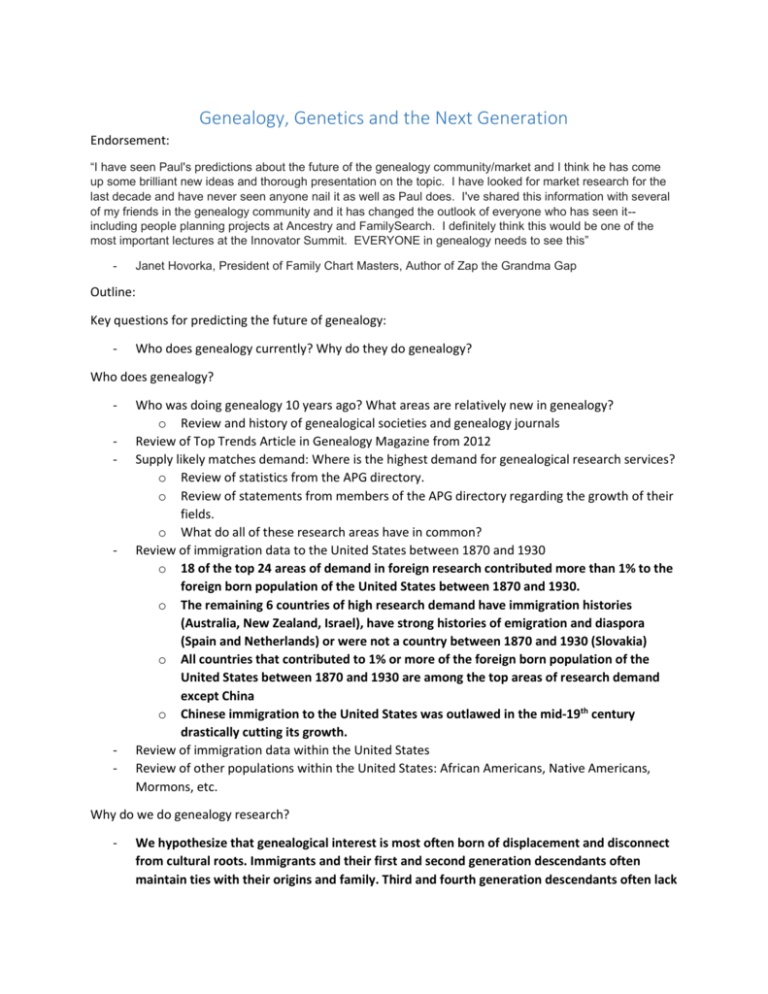
Genealogy, Genetics and the Next Generation Endorsement: “I have seen Paul's predictions about the future of the genealogy community/market and I think he has come up some brilliant new ideas and thorough presentation on the topic. I have looked for market research for the last decade and have never seen anyone nail it as well as Paul does. I've shared this information with several of my friends in the genealogy community and it has changed the outlook of everyone who has seen it-including people planning projects at Ancestry and FamilySearch. I definitely think this would be one of the most important lectures at the Innovator Summit. EVERYONE in genealogy needs to see this” - Janet Hovorka, President of Family Chart Masters, Author of Zap the Grandma Gap Outline: Key questions for predicting the future of genealogy: - Who does genealogy currently? Why do they do genealogy? Who does genealogy? - - - Who was doing genealogy 10 years ago? What areas are relatively new in genealogy? o Review and history of genealogical societies and genealogy journals Review of Top Trends Article in Genealogy Magazine from 2012 Supply likely matches demand: Where is the highest demand for genealogical research services? o Review of statistics from the APG directory. o Review of statements from members of the APG directory regarding the growth of their fields. o What do all of these research areas have in common? Review of immigration data to the United States between 1870 and 1930 o 18 of the top 24 areas of demand in foreign research contributed more than 1% to the foreign born population of the United States between 1870 and 1930. o The remaining 6 countries of high research demand have immigration histories (Australia, New Zealand, Israel), have strong histories of emigration and diaspora (Spain and Netherlands) or were not a country between 1870 and 1930 (Slovakia) o All countries that contributed to 1% or more of the foreign born population of the United States between 1870 and 1930 are among the top areas of research demand except China o Chinese immigration to the United States was outlawed in the mid-19th century drastically cutting its growth. Review of immigration data within the United States Review of other populations within the United States: African Americans, Native Americans, Mormons, etc. Why do we do genealogy research? - We hypothesize that genealogical interest is most often born of displacement and disconnect from cultural roots. Immigrants and their first and second generation descendants often maintain ties with their origins and family. Third and fourth generation descendants often lack - - cultural ties to their immigrant ancestors’ homelands and families. Interest in genealogy increases 75-120 years after migration. Economic considerations Cultural considerations Political considerations Maslow’s hierarchy of needs Three levels of genealogical research as described by Tom Jones at SCGS banquet 2015 o Names, dates and places o Stories o Research History of journal content in family history journals What do these observations mean for the future of genealogy? - - In the United States, what areas are growing in genealogical demand? Who is up next? o Finland, Greece, Yugoslavia, Lithuania, Romania 20 years from now? o Netherlands, China, Japan 50 years from now? o Portugal, Cuba, India, Philippines, Korea, Vietnam, El Salvador, Dominican Republic, Guatemala What is immigration like in other areas of the world? o China and India to Canada o Former colonies to former colonial powers South America to Europe, Sub Saharan Africa and Northern Africa to Europe Southeast Asia to Europe o European Jews to Israel o Southeast Asia to the Middle East Review of record availability and archival practices in up-and-coming genealogy markets How can genetic genealogy help? Brief review of genetic genealogy technologies Who is doing genetic genealogy right now? - General interest and ethnicity Adoption Unknown paternity Single parent households Blended families Donor conception Review of statistics of important contributing causes for genetic genealogy In many cases, demand for traditional genealogy manifests itself 75-120 years after disconnect and displacement. For many cases leading to interest in genetic genealogy, demand is immediate since disconnect is immediate. Demand for cases in genetic genealogy often manifests itself within the lifetime of the affected individual: 20-75 years after the event of disconnect. Who will be doing genetic genealogy in the future? As incidence of all contributing demographic patterns increase, genetic genealogy will become an increasingly vital part of the field of family history. What needs to be done to prepare for the future? - Record preservation and acquisition in future high-demand areas Testing initiatives in future countries and areas of interest o Crowdfunding options o Genetic genealogy education o Family history education Conclusion
